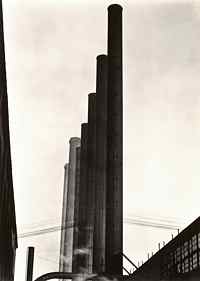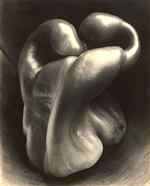This text about Edward Weston (March 24, 1886 to January 1, 1958) came from an article in the Museum members' magazine.
'Edward Weston: Life Work surveys 100 images by one of the 20th century's most influential photographers. It
 features all of Weston's best-known subjects -- nudes, landscapes, portraits, buildings, shells and peppers -- in an outstanding group of vintage prints drawn from five decades of Weston's career. The exhibition begins with Weston working in a soft-focus, Pictorialist style, and ends with his starkly poetic landscapes featuring the central California coast where he made his home, especially Point Lobos and Carmel. Previously unpublished masterpieces are interspersed with well-known signature images.
features all of Weston's best-known subjects -- nudes, landscapes, portraits, buildings, shells and peppers -- in an outstanding group of vintage prints drawn from five decades of Weston's career. The exhibition begins with Weston working in a soft-focus, Pictorialist style, and ends with his starkly poetic landscapes featuring the central California coast where he made his home, especially Point Lobos and Carmel. Previously unpublished masterpieces are interspersed with well-known signature images.'Born in Highland Park, Illinois, Weston (1886-1958) discovered photography in his youth with a camera given to him by his father. He began his professional career in Southern California in the early 1900s as a surveyor for the railroads. After a brief period of study at the Illinois College of Photography, he returned to Southern California in 1908 and became a founding member of the Camera Pictorialists of Los Angeles. He married the next year, depicting his new bride, Flora Chandler, in a striking study (perhaps Weston's first nude), which is included in the exhibition. In 1911, he opened his own studio. He supported his family for 10 years through commercial photography while pursuing his artistic interests on the side. (right: Edward Weston, Armco Steel, Ohio, 1922. Gelatin silver print. ©1981, CCP, Arizona, Board of Regents)
'In his early career, Weston became a leader among photographers working in the Pictorialist style, a soft-focus approach that aimed to put photography on a par with painting. In the early 1920s, he began to pursue a more streamlined, sharply focused aesthetic, famously captured in Armco Steel, Ohio, a photograph that marked Weston's final break from Pictorialism and studio work.

'Weston pursued his new approach during a three-year sojourn in Mexico in the mid-1920s, producing signature images such as Excusado (a study of a toilet), and Heaped Black Ollas. Traveling in the company of Italian actress and photographer Tina Modotti, his model, muse and protégé, Weston also produced memorable images of her, as well as portraits of the country's culturati, including artists José Clemente Orozco, Diego Rivera and author D. H. Lawrence, who was there doing research for a novel. Weston also began to focus on close-ups of natural phenomena, like vegetables, shells, trees, rocks and clouds. (left: Edward Weston, Ollas de Oaxaca, 1926. Gelatin silver print. ©1981, CCP, Arizona, Board of Regents)
'Upon his return to California in 1927, Weston continued to experiment with pure form and disconcerting shifts of scale through his long exposures of shells, peppers, mushrooms and radishes. In Carmel, where he lived from 1929 to 1935, he added close-ups of gnarled cypresses, rocks and kelp to his repertoire. These still lifes and nature studies segue naturally into a remarkable set of sculptural nudes produced in 1933 and 1934. It was during this period that he became a charter member of the Group f/64, which included

'Ansel Adams, Imogen Cunningham, Consuelo Kanaga and others. They chose this optical term because they habitually set their lenses to that aperture to secure maximum image sharpness of both foreground and distance. (right: Edward Weston, Pepper No. 30, 1930. Gelatin silver print. ©1981, CCP, Arizona, Board of Regents)
'Beginning to concentrate increasingly on the open landscape, Weston then pulled back and loosened his style. A suite of six magnificent images of sand dunes (1934 to 1946) made near Oceano, California, are included in the exhibition. Traveling the country with the support of a Guggenheim grant, he also made studies of desert landscape detritus-such as a dead buzzard and the wreck of a burned car.
'Weston met the beautiful Charis Wilson in 1934 and divorced his first wife, Flora, three years later. His 1939 marriage to Wilson lasted seven years. Wilson became his model for a series of sensuous nudes posed on the Oceano dunes. The couple eventually moved to a house built by Weston's son Neil on Wildcat Hill, near Carmel. Diagnosed with Parkinson's disease in 1946, Weston produced his consummate final photograph in 1948, The "Dody Rocks," Point Lobos ("Something out of Nothing"), bringing the photographer's career, and the exhibition, to conclusion. ....'
Not sure how many cats were in the show above, but this photo might be the best photograph of a cat, in the world.

This is 'Johnny' (1944) by Edward Weston. This photo was in a MOMA show of Weston's work.
1 comment:
Love the way all the elements came together to express the feline expression.
Post a Comment